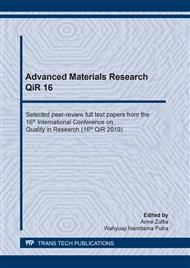[1]
T. B. Joewono and H. Kubota, The characteristics of paratransit and non-motorized transport in Bandung, Indonesia,, J. East. Asia Soc. Transp. Stud., vol. 6, p.262–277, (2005).
Google Scholar
[2]
A. Suppapitnarm, G. T. Parks, K. Shea, and P. J. Clarkson, Conceptual design of bicycle frames by multiobjective shape annealing,, Eng. Optim., vol. 36, no. 2, p.165–188, (2004).
DOI: 10.1080/03052150310001633214
Google Scholar
[3]
F. Fuerle and J. Sienz, Decomposed surrogate based optimization of carbon-fiber bicycle frames using Optimum Latin Hypercubes for constrained design spaces,, Comput. Struct., vol. 119, p.48–59, (2013).
DOI: 10.1016/j.compstruc.2012.11.014
Google Scholar
[4]
A. N. Thite, S. Gerguri, F. Coleman, M. Doody, and N. Fisher, Development of an experimental methodology to evaluate the influence of a bamboo frame on the bicycle ride comfort,, Veh. Syst. Dyn., vol. 51, no. 9, p.1287–1304, (2013).
DOI: 10.1080/00423114.2013.797591
Google Scholar
[5]
M. R. Sanjay, G. R. Arpitha, and B. Yogesha, Study on mechanical properties of natural-glass fibre reinforced polymer hybrid composites: A review,, Mater. today Proc., vol. 2, no. 4–5, p.2959–2967, (2015).
DOI: 10.1016/j.matpr.2015.07.264
Google Scholar
[6]
J. R. Vinson and R. L. Sierakowski, The behavior of structures composed of composite materials, vol. 105. Springer Science & Business Media, (2006).
Google Scholar
[7]
A. Shahzad, Hemp fiber and its composites–a review,, J. Compos. Mater., vol. 46, no. 8, p.973–986, (2012).
Google Scholar
[8]
M. C. Khoathane, O. C. Vorster, and E. R. Sadiku, Hemp fiber-reinforced 1-pentene/polypropylene copolymer: the effect of fiber loading on the mechanical and thermal characteristics of the composites,, J. Reinf. Plast. Compos., vol. 27, no. 14, p.1533–1544, (2008).
DOI: 10.1177/0731684407086325
Google Scholar
[9]
L. Di Landro and G. Janszen, Composites with hemp reinforcement and bio-based epoxy matrix,, Compos. Part B Eng., vol. 67, p.220–226, (2014).
DOI: 10.1016/j.compositesb.2014.07.021
Google Scholar
[10]
Y. S. Song, J. R. Youn, and T. G. Gutowski, Life cycle energy analysis of fiber-reinforced composites,, Compos. Part A Appl. Sci. Manuf., vol. 40, no. 8, p.1257–1265, (2009).
DOI: 10.1016/j.compositesa.2009.05.020
Google Scholar
[11]
I. Suriadi and I. K. A. Atmika, Mechanical properties and fluid absorption at the brake lining of hybrid composite,, in IOP Conference Series: Materials Science and Engineering, 2019, vol. 539, no. 1, p.12015.
DOI: 10.1088/1757-899x/539/1/012015
Google Scholar
[12]
P. J. Herrera-Franco and A. Valadez-Gonzalez, Mechanical properties of continuous natural fibre-reinforced polymer composites,, Compos. Part A Appl. Sci. Manuf., vol. 35, no. 3, p.339–345, (2004).
DOI: 10.1016/j.compositesa.2003.09.012
Google Scholar
[13]
N. Saba, M. Jawaid, O. Y. Alothman, and M. T. Paridah, A review on dynamic mechanical properties of natural fibre reinforced polymer composites,, Constr. Build. Mater., vol. 106, p.149–159, (2016).
DOI: 10.1016/j.conbuildmat.2015.12.075
Google Scholar
[14]
N. Lu and S. Oza, Thermal stability and thermo-mechanical properties of hemp-high density polyethylene composites: effect of two different chemical modifications,, Compos. Part B Eng., vol. 44, no. 1, p.484–490, (2013).
DOI: 10.1016/j.compositesb.2012.03.024
Google Scholar
[15]
A. Shahzad, Effects of water absorption on mechanical properties of hemp fiber composites,, Polym. Compos., vol. 33, no. 1, p.120–128, (2012).
DOI: 10.1002/pc.21254
Google Scholar
[16]
M. Ramesh, K. Palanikumar, and K. H. Reddy, Mechanical property evaluation of sisal-jute-glass fiber reinforced polyester composites,, Compos. Part B Eng., vol. 48, pp.1-9, (2013).
DOI: 10.1016/j.compositesb.2012.12.004
Google Scholar


